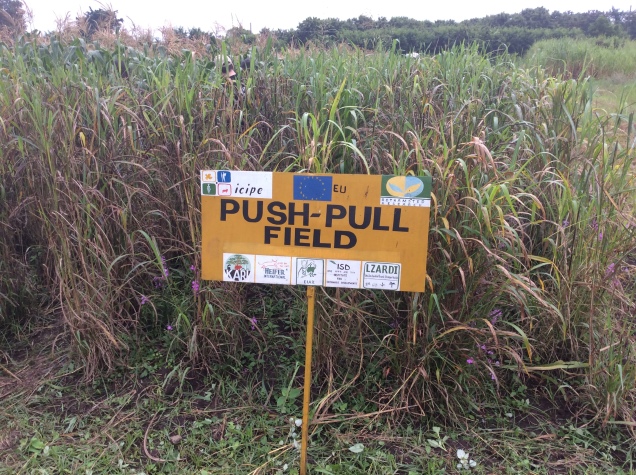
After leaving Rusinga we traveled a short distance to ICIPE at Mbita Point. This is where Dr Khan (left in the picture) has been developing the “push-pull “technology for maize growing in this area. The evening we arrived we had dinner with Professor Wadhams and his wife who are here on holiday. Professor Wadhams co-developed push-pull with Dr Khan.
Push-pull is probably the most powerful example of the beneficial effects of intercropping I will see. The problems of growing maize in this area of East Africa is a parasitic weed called Striga

As shown above the Striga attaches to the root of the maize and sucks all the nutrients. The other problem is stem-borer. It is the larval stage of a moth that bores into the stem of the maize again taking nutrients from the maize

The push-pull has been developed using Desmodium a legume and Napier grass to trick the moth and the Striga

There is a lot of information on http://www.push-pull.net The Desmodium tricks the Striga into suicidal germination and repels the moth of the stem borer. Then the Napier grass attracts the moth to it where lays it eggs instead of on the maize.

This is the first push-pull field which has been going for 15 years. This technology has increased the maize yields from 1.5t/ha to over 5t/ha and has been taken up by 110,000 farms in East Africa. There are other benefits of the system. The Desmodium and the Napier grass can be used livestock feed. The Desmodium provides Nitrogen and is a weed suppressant. They only have to weed once instead of 3 times and only in a small strip not all over. The other benefit is that it is relatively cheap to run. The Desmodium seed is a one off cost. The system can also be used in sorghum and millet.

Above is showing the difference between with (left) and without (right) push-pull. It is pretty dramatic.
After a few years there became a problem in very dry years that the variety of Desmodium would not survive the drought and so needed to be replanted and the Napier grass developed a disease called Napier Stunt. This led to the second generation Climate Smart Push Pull. They now use a drought tolerant variety of Desmodium and a different grass called Brachiaria.

Above is a plot that is ready to be planted with maize. They have also tried to work out what the effect of the Desmodium is on Striga. Is it shading of Striga, Nitrogen effect on the maize or root exudates

The results seem to show that the root exudates have the biggest effects.
The major side benefit of the Push-Pull is the production of fodder for the animal. So at ICIPE they are trialling best practise for fodder harvest, usage and ensiling

They are also measuring the production benefits and increases in the livestock production

Another interesting benefit of the Napier grass is that is repels tics so they surround their stall with Napier grass.
We really had a fascinating morning with so much information that I could not fit it all into this blog and I would recommend people visit the website for more information. It is a great example of how to use Mother Nature to your own benefit without large costs which makes it ideal for the small holders. Many thank to the team at ICIPE.